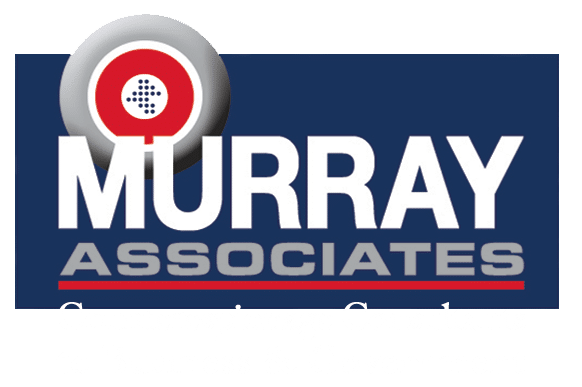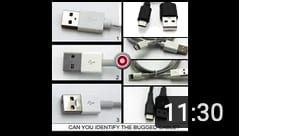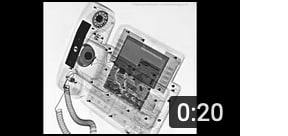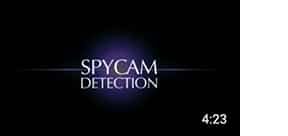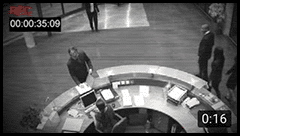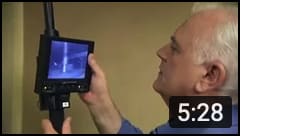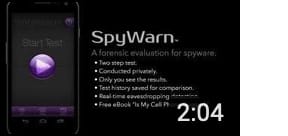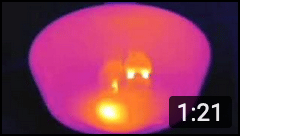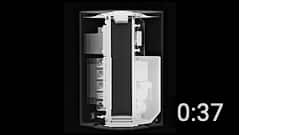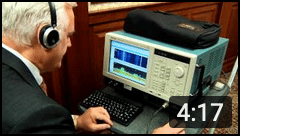![]()
This TSCM video page will answer many of your questions about security, counterespionage measures and the different techniques and equipment involved in the worlds of espionage and counterespionage. We hope you find them informative. If you still have questions after viewing them, feel free to contact us.
 Malicious USB Spy Cables & How You Can Detect Them
Malicious USB Spy Cables & How You Can Detect Them
A malicious spy cable is any cable (electrical or optical) which performs an unexpected, and unwanted function. The most common malicious capabilities are found in USB cables. Data exfiltration, GPS tracking, and audio eavesdropping are the primary malicious functions. (11:30)
 Hotel / Conference Center Eavesdropping
Hotel / Conference Center Eavesdropping
Countering corporate espionage involves more than just not discussing business in public. FM wireless microphones, commonly used in business meetings, can be intercepted from up to a mile away. Watch how a corporate espionage spy takes advantage of this. (1:59)
 USB Voice Recorder in the Boardroom
USB Voice Recorder in the Boardroom
Bugging a boardroom is simple and can be implemented in a matter of seconds. See how easily the corporate espionage spy can compromise a board meeting. (1:59)
 The Infrared Door Lock Bypass Trick
The Infrared Door Lock Bypass Trick
There are many ways someone can enter your offices to plant bugs and other electronic surveillance devices. This is just one example. Alerting our clients to these vulnerabilities is just part of our counterespionage service. (1:30)
 Bug in the Office
Bug in the Office
See how easily your office could be bugged, and your intellectual property could be put at risk. (1:36)
 X-ray of a Business Telephone – A Bug Detection Technique
X-ray of a Business Telephone – A Bug Detection Technique
A quick look into a desktop telephone to inspect it for implanted eavesdropping devices. Fortunately, were none seen. Do you have eavesdropping or corporate espionage concerns? Contact us. (0:20)
 Spycam Detection Training
Spycam Detection Training
A quick reminder about the importance of learning how to detect spy cameras in areas where privacy is expected. (0:16)
 How to Detect Spy Cameras
How to Detect Spy Cameras
Preview of a one-hour, online, self-paced video training course, originally created for a Fortune 50 company. (4:23)
 This American Life — “Spies Like Us”
This American Life — “Spies Like Us”
An audio only interview with Kevin D. Murray about the professional TSCM inspections he conducts for business and government begins at 6:05. Courtesy – PRI – Public Radio International (14:22)
 The Competitive Advantage Fail
The Competitive Advantage Fail
A quick cautionary tale about a company that didn’t cover all its corporate espionage loopholes. (0:16)
 The Wand Wavers
The Wand Wavers
The term “wand” refers to an antenna. A wand waver is a person pretending to know what they are doing. They can be very glib and convincing. Fact: Nine out of ten sweep teams are not in the top 10% of their field. (0:16)
 The Nightmare Visitor
The Nightmare Visitor
Is he an employee coming to work?
Is he a vendor attending a proposal meeting?
Is he here to repair something? It doesn’t matter.
He was allowed onto your premises for a legitimate purpose. (0:16)
 Discovery Channel – Daily Planet – Murray Associates Interview
Discovery Channel – Daily Planet – Murray Associates Interview
If you have ever wanted to observe a bug sweep team in action, this is your chance! The Daily Planet interviewed the Murray Associates technicians as they conducted an electronic eavesdropping detection audit. The video clip shows them conducting spectrum analysis, nonlinear junction detection, infrared detection, a Wi-Fi security and compliance audit, and other activities. (5:27 – Low resolution. Posted for informational value. Retired versions of our instrumentation shown.)
Transcript:
Male host – But first. Speaking of technology, as we seem to be all the time, it seems getting to be harder and harder to keep electronic file safe. In fact the world of corporate secrets, protecting files is Big Business.
Female host – That’s right. Corporate espionage is alive and well, which is why there are companies coming out with some highly sophisticated technologies to help sniff out a spy. We hooked up with one to see what they can do.
(music)
Male host – An important meeting is about to take place in this New York hotel. But before it happens Kevin Murray’s team is going to shake down this room. It’s his job to make sure company secrets stay that way.
Kevin – You never know who you’re going to run into. Could be anybody from a foreign government, right on down to the secretary, who just wants to know what the boss is up to.
Male host – Kevin Murray is an expert in eavesdropping.
Kevin – The telephone is the most dangerous instrument in the office. Of course you can wiretap it. Everybody knows that. But they don’t realize is that the telephone itself has a couple of microphones in it and a couple speakers in it which can also be used as microphones. It also has plenty of open space inside, and it has power coming to it all the time. And, if that weren’t bad enough, it’s right on the desk in front of the person you want to listen to.
Male host – Kevin’s been doing this for more than 30 years and he’s got some pretty sophisticated equipment that lets him see into unusual places.
Kevin – …and ceiling in this room probably about 12 to 15 feet up. So, we’re going to take our little eyeball and just push up the ceiling tile. And, now we can poke around and see what’s going on upstairs.
Male host – Some things aren’t visible to the human eye which is why they have this.
Andrew – So, this is a thermal imaging camera, which we use to look for sources of heat in the room. Basically, anything that’s electronic and has current running through it heats up, like your television at home.
Male host – It is super-sensitive to heat.
Kevin – Here is an example of just how little heat this camera sees. I’m going to take a look at my fingertip and the heat coming from off of that.
(music while drawing on the wall)
That’s amazing; it really is amazing. But that’s the worst-case scenario. A bug would look a little bit more like this. (shows heat hand print on the wall)
(music)
Male host – So far, they haven’t found anything in the ceiling or the walls. Time to sweep the rest of the boardroom.
Kevin – Our next test involves an instrument called a Nonlinear Junction Detector. It is one of the basic tests in electronic countermeasures. Very simply what it does is it sends out a radio signal. When the signal hits something like a transistor, or a diode, also called a nonlinear junction, it reflects back to us at twice the frequency.
Bill – Initially, when we come into a room I try to tag every object in the room. And, as I sweep it over, I could actually go quite quickly, to accommodate the size of the room, but I do it carefully enough so every indication I get I can analyze and see what it’s giving me. As a case in point here, I’m getting an incredibly high reading for a nonlinear junction, so that forces me to go and resolve what that anomaly is. In this case, it’s our test strip, that we utilize, literally, for testing.
Male host – Even if Kevin can’t find a bug he can tell if information is going to the wrong person. This state-of-the-art equipment tracks hidden radio signals.
Kevin – Our next instrument is a spectrum analyzer. This is a very special instrument. The thing that is special about this is that it allows us to see signals behind the signals. FM transmitters, like your FM broadcast FM radio stations, they transmit all the time, very strong signals, they make an ideal location for hiding your other signal. Normally you can’t see that. That’s very very difficult to discover. This is one of the few instruments that does that.
Male host – No bugs here but there are other ways to spy on a company.
Kevin – All it takes takes is somebody with a setup like this to be out in the parking lot, and hook onto one of the computers on the inside, and go all the way into the mainframe, if the security settings are not correct.
Male host – This machine looks unusual Wi-Fi transmissions.
Kevin – As we look as these transmissions, we can tell what they are associated with, whether it be a laptop or a handheld portable device like a tablet or telephone.
Male host – Although they have scanned the room completely and find no signs of espionage the job does not end here.
Kevin – The sweep of the room went well. We did not find any electronic eavesdropping devices, but this is a pre-meeting inspection. Normally it does not end at this point. The meeting usually commences right after we’re finished and we go to another location and set up the radio receivers, and continue monitoring for things that might be brought into the room at the last minute, by somebody on the staff, or maybe by one of the meeting participants themselves.
Male host – By listening in, Kevin has found a way to keep company secrets.
 SpyWarn 2.0
SpyWarn 2.0
Introduction to the SpyWarn 2.0 Android app that can evaluate your smartphone for spyware. Includes the e-book version of: “Is My Cell Phone Bugged? Everything You Need to Know to Keep Your Mobile Conversations Private.” (2:04)
 “Someone’s Watching”
“Someone’s Watching”
The New York Times / Discovery Channel documentary with Murray Associates explaining eavesdropping detection and the specialized instrumentation that helps discover spying. (2:42 – Low resolution. Posted for informational value. Retired versions of our instrumentation shown.)
 An Infrared Thermal Camera for TSCM Bug Detection
An Infrared Thermal Camera for TSCM Bug Detection
Thermal Emissions Spectrum Analysis (TESA) is an electronic eavesdropping detection technology pioneered by Murray Associates and used during their TSCM bug sweeps for businesses and governments. (1:21, low resolution)
 X-ray of an Apple AirPort Wi-Fi
X-ray of an Apple AirPort Wi-Fi
Murray Associates’ TSCM tested X-ray analysis. Used when the stakes are high and the opposition is sophisticated. (0:37)
HBO – “K Street” – The TSCM Inspection
Kevin D. Murray of Murray Associates conducts an eavesdropping detection audit and provides a debriefing to James Carville and Mary Matalin. (Executive Producers: George Clooney and Steven Soderbergh, 4:15 – Low resolution. Posted for informational value. Retired versions of our instrumentation shown.)
Synopsis: As the show opens, the offices of Bergstrom Lowell are being searched for listening devices. James Carville and Mary Matalin talk to Kevin D. Murray, a consultant, about increasing their “perimeter security.” He points out that none of the offices have locks on the doors, and suggests shredding their garbage and installing a noise masking system to thwart eavesdroppers. When Matalin wonders if they’re just being paranoid, Murray tells them to trust their instincts if they feel something is wrong. Apparently, all these precautions are in response to suspicions about the real-life leak to columnist Robert Novak of the name of a CIA operative.
Secrets for Sale
Discussion of business espionage, corporate-level debugging (TSCM) and the electronic countermeasures instrumentation involved, with Kevin D. Murray. Especially important is the FBI’s warning. (3:05 – Posted for informational value. Retired versions of our instrumentation shown.)
 Fox News Show “212 On Assignment: The TSCM Sweep”
Fox News Show “212 On Assignment: The TSCM Sweep”
Fox News follows Murray Associates on an assignment. (5:43 – Low resolution. Posted for informational value. Retired versions of our instrumentation shown.)
About Murray Associates
Who we are. What we do. How we can help you. (4:17 – Posted for informational value. Retired versions of our instrumentation shown.)
Have a Question About TSCM?
If you have any questions about the TSCM consulting services provided by Murray Associates, simply fill out the form below or call us from a safe area and phone.
If you believe you are under active electronic surveillance, or believe you have discovered a bug or covert video camera, visit our Emergency TSCM page. The procedural checklist there will guide you on the next steps to take.
